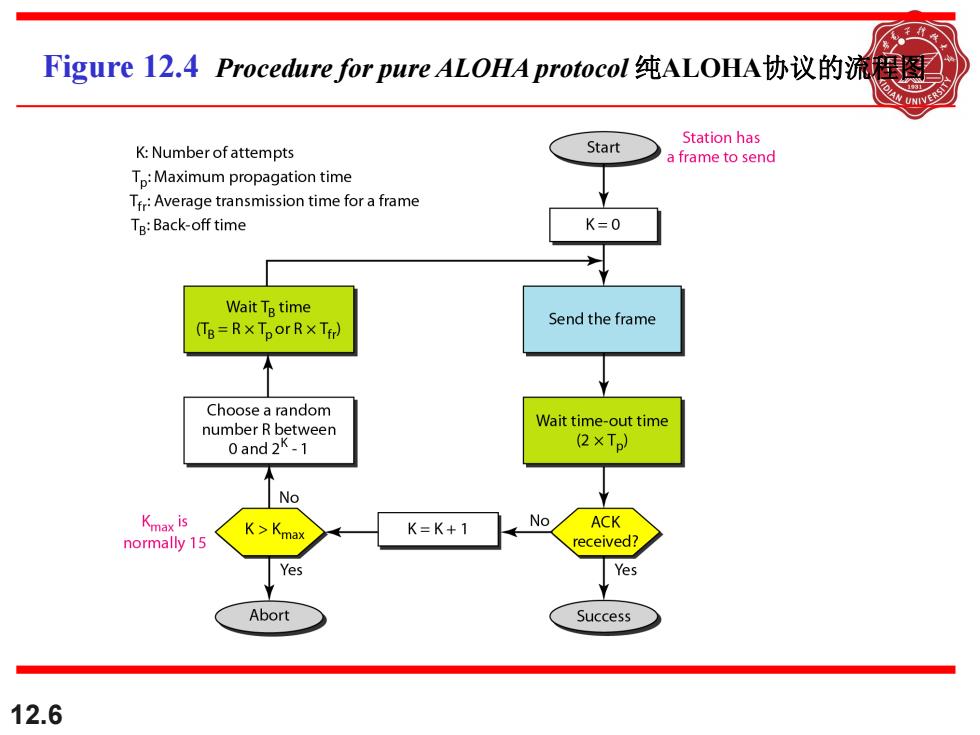
Figure12.4 Procedure for pure ALOHA protocol纯ALOHA协议的流 Station has K:Number of attempts Start a frame to send Tp:Maximum propagation time Tr:Average transmission time for a frame Tg:Back-off time K=0 Wait Tg time (TB=R×Tpor RXT) Send the frame Choose a random number R between Wait time-out time 0and 2K-1 (2×Tp) No Kmax is K=K+1 No ACK a normally 15 received? Yes Yes Abort Success 12.6
12.6 Figure 12.4 Procedure for pure ALOHA protocol 纯ALOHA协议的流程图
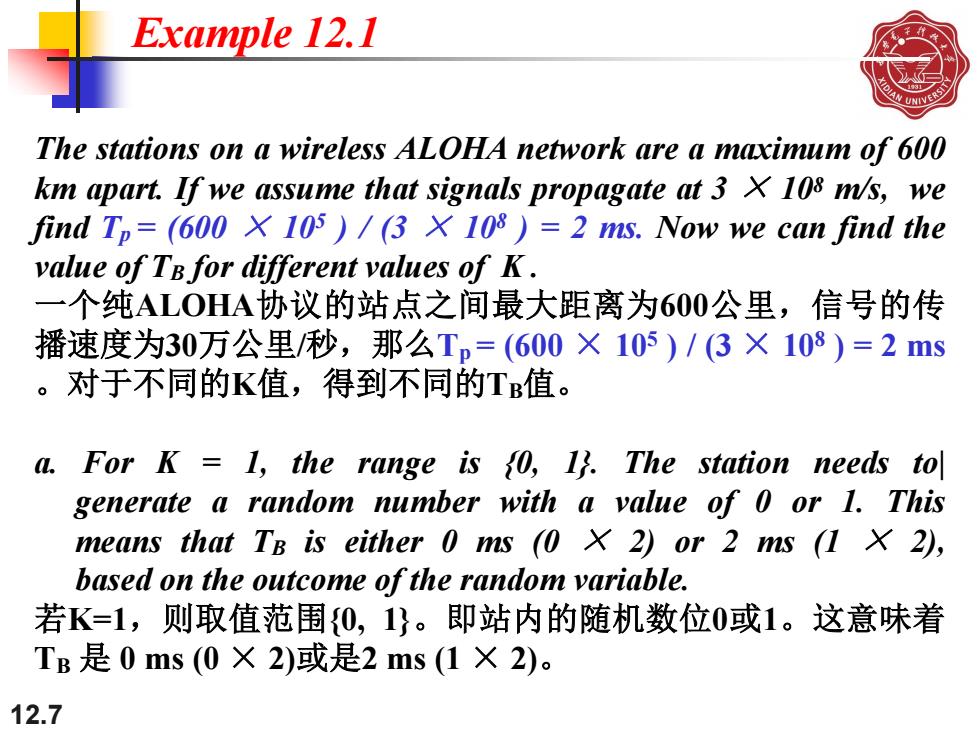
Example 12.1 The stations on a wireless ALOHA network are a maximum of 600 km apart.If we assume that signals propagate at 3 X 108 m/s,we find Tp=(600 X 105)/(3 X 108)=2 ms.Now we can find the value of Te for different values of K. 一个纯ALOHA协议的站点之间最大距离为600公里,信号的传 播速度为30万公里/秒,那么Tp=(600×105)/(3×108)=2ms 。对于不同的K值,得到不同的T值。 For K 1,the range is 0,1.The station needs to generate a random number with a value of 0 or 1.This means that TB is either 0 ms (0 X 2)or 2 ms (1 X 2), based on the outcome of the random variable. 若K=1,则取值范围{0,1}。即站内的随机数位0或1。这意味着 TB是0ms(0X2)或是2ms(1X2)。 12.7
12.7 The stations on a wireless ALOHA network are a maximum of 600 km apart. If we assume that signals propagate at 3 × 108 m/s, we find Tp = (600 × 105 ) / (3 × 108 ) = 2 ms. Now we can find the value of TB for different values of K . 一个纯ALOHA协议的站点之间最大距离为600公里,信号的传 播速度为30万公里/秒,那么Tp = (600 × 105 ) / (3 × 108 ) = 2 ms 。对于不同的K值,得到不同的TB值。 a. For K = 1, the range is {0, 1}. The station needs to| generate a random number with a value of 0 or 1. This means that TB is either 0 ms (0 × 2) or 2 ms (1 × 2), based on the outcome of the random variable. 若K=1,则取值范围{0, 1}。即站内的随机数位0或1。这意味着 TB 是 0 ms (0 × 2)或是2 ms (1 × 2)。 Example 12.1
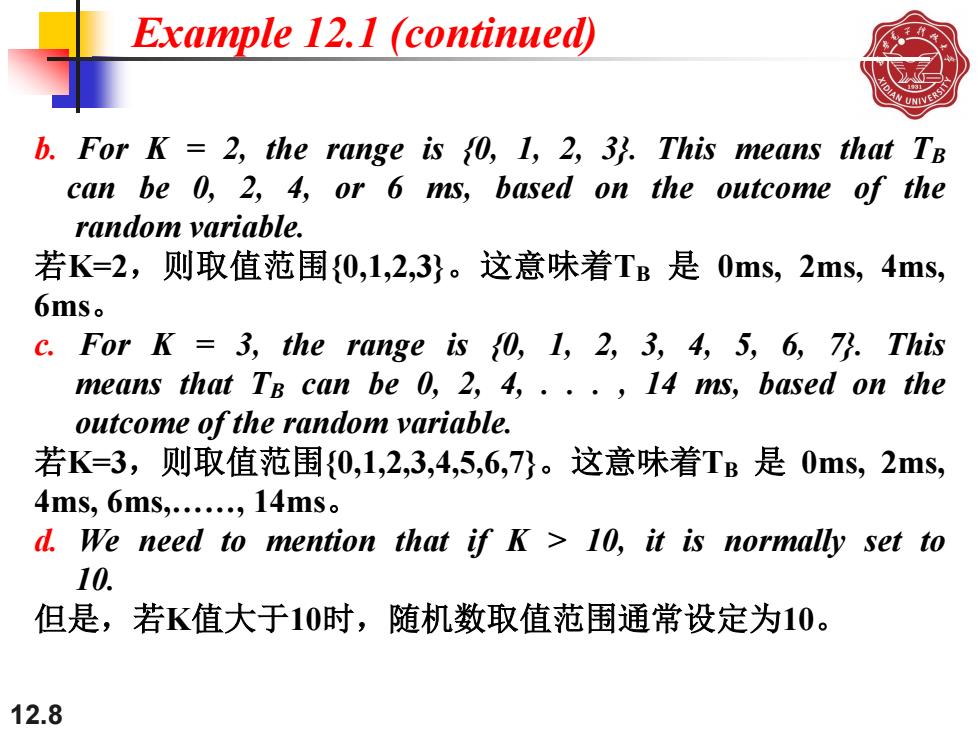
Example 12.1 (continued) UNIN b.For K -2,the range is 1,2,3.This means that TB can be 0,2,4,or 6 ms,based on the outcome of the random variable. 若K=2,则取值范围{0,1,2,3}。这意味着TB是0ms,2ms,4ms, 6ms。 c.For K -3,the range is 1,2,3,4,5,6,7.This means that Ts can be 0,2,4,··.,l4s,based on the outcome of the random variable. 若K=3,则取值范围{0,1,2,3,4,5,6,7}。这意味着TB是0ms,2ms, 4ms,6ms,.,14ms。 d.We need to mention that if K 10,it is normally set to 10. 但是,若K值大于10时,随机数取值范围通常设定为10。 12.8
12.8 b. For K = 2, the range is {0, 1, 2, 3}. This means that TB can be 0, 2, 4, or 6 ms, based on the outcome of the random variable. 若K=2,则取值范围{0,1,2,3}。这意味着TB 是 0ms, 2ms, 4ms, 6ms。 c. For K = 3, the range is {0, 1, 2, 3, 4, 5, 6, 7}. This means that TB can be 0, 2, 4, . . . , 14 ms, based on the outcome of the random variable. 若K=3,则取值范围{0,1,2,3,4,5,6,7}。这意味着TB 是 0ms, 2ms, 4ms, 6ms,., 14ms。 d. We need to mention that if K > 10, it is normally set to 10. 但是,若K值大于10时,随机数取值范围通常设定为10。 Example 12.1 (continued)
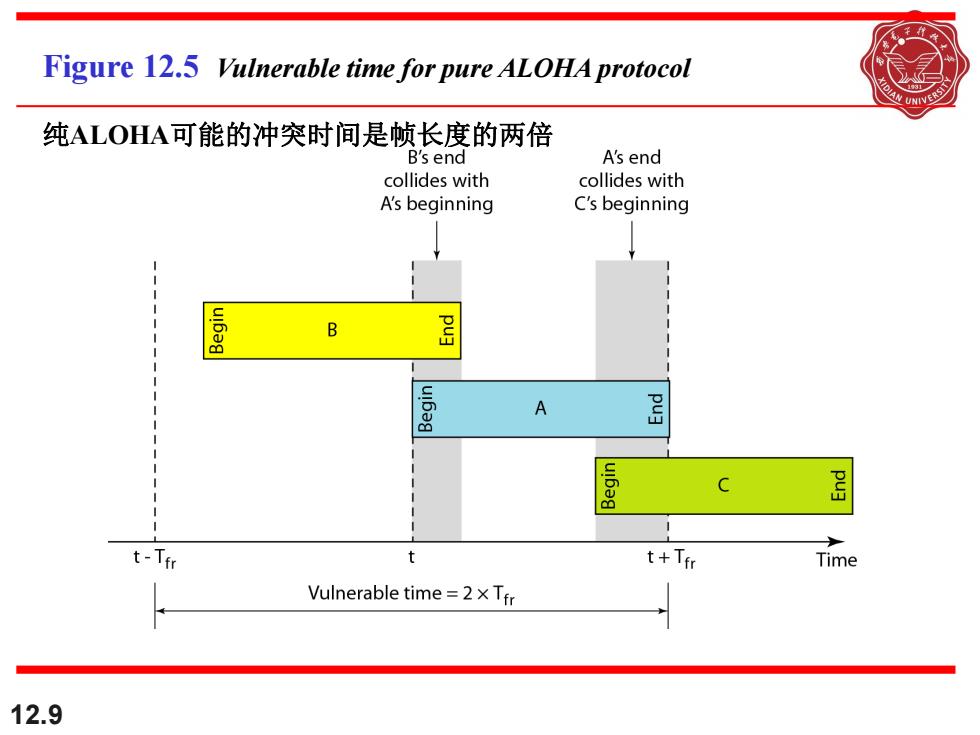
Figure 12.5 Vulnerable time for pure ALOHA protocol 纯ALOHA可能的冲突时间是帧长度的两倍 B's end A's end collides with collides with A's beginning C's beginning 感 B 器 A 器 盈 器 t-Tfr t+Tir Time Vulnerable time =2 x Tfr 12.9
12.9 Figure 12.5 Vulnerable time for pure ALOHA protocol 纯ALOHA可能的冲突时间是帧长度的两倍
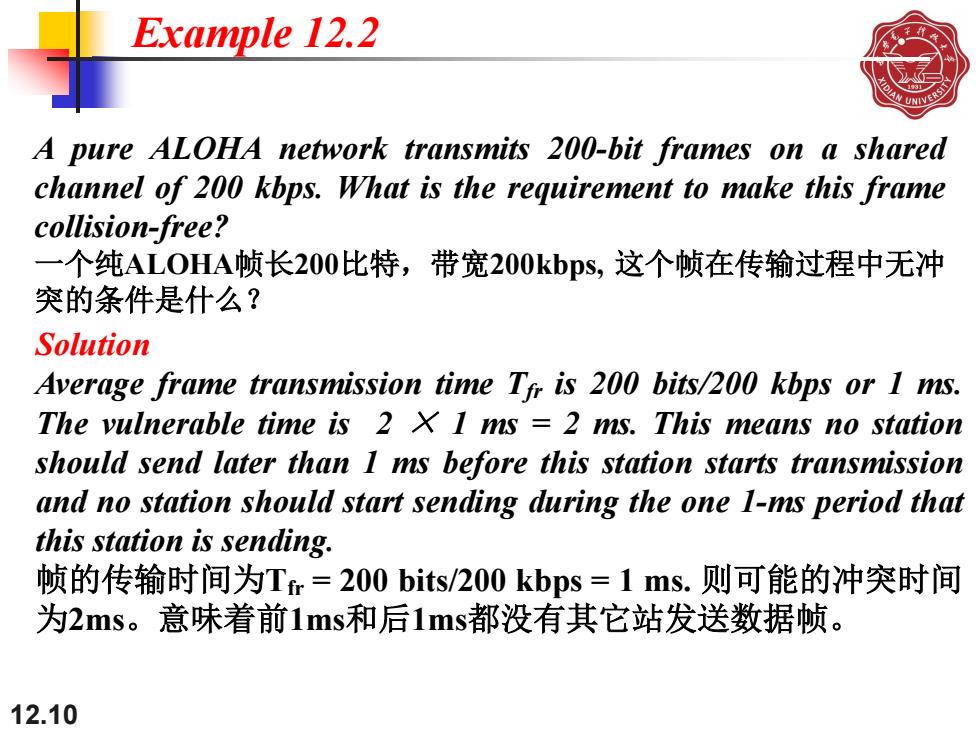
Example 12.2 UNI A pure ALOHA network transmits 200-bit frames on a shared channel of 200 kbps.What is the requirement to make this frame collision-free? 一个纯ALOHA帧长200比特,带宽200kbps,这个帧在传输过程中无冲 突的条件是什么? Solution Average frame transmission time Tfr is 200 bits/200 kbps or I ms. The vulnerable time is 2 X I ms 2 ms.This means no station should send later than I ms before this station starts transmission and no station should start sending during the one 1-ms period that this station is sending. 帧的传输时间为Tr=200bits/200kbps=1ms.则可能的冲突时间 为2ms。意味着前1ms和后1ms都没有其它站发送数据帧。 12.10
12.10 A pure ALOHA network transmits 200-bit frames on a shared channel of 200 kbps. What is the requirement to make this frame collision-free? 一个纯ALOHA帧长200比特,带宽200kbps, 这个帧在传输过程中无冲 突的条件是什么? Example 12.2 Solution Average frame transmission time Tfr is 200 bits/200 kbps or 1 ms. The vulnerable time is 2 × 1 ms = 2 ms. This means no station should send later than 1 ms before this station starts transmission and no station should start sending during the one 1-ms period that this station is sending. 帧的传输时间为Tfr = 200 bits/200 kbps = 1 ms. 则可能的冲突时间 为2ms。意味着前1ms和后1ms都没有其它站发送数据帧